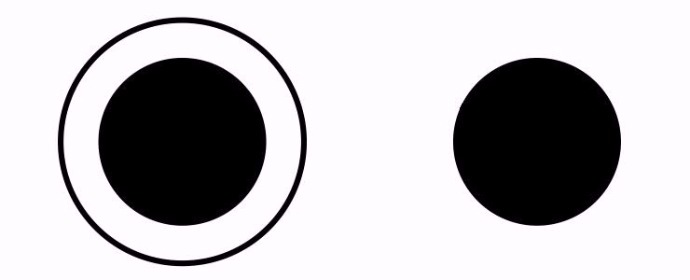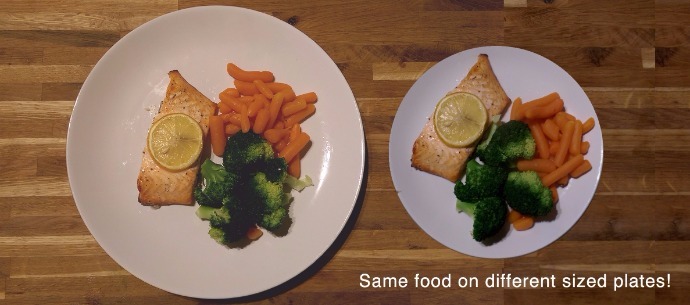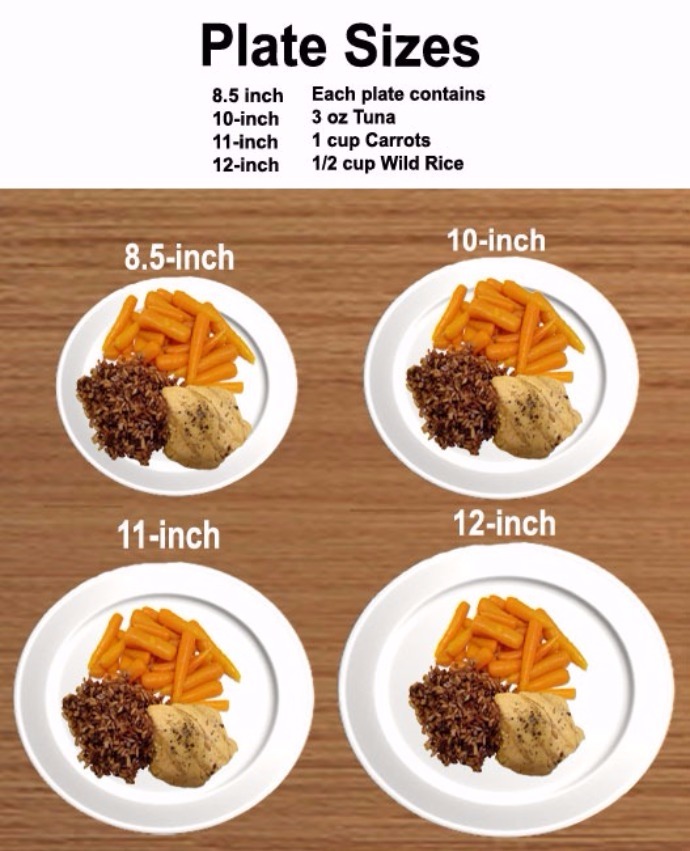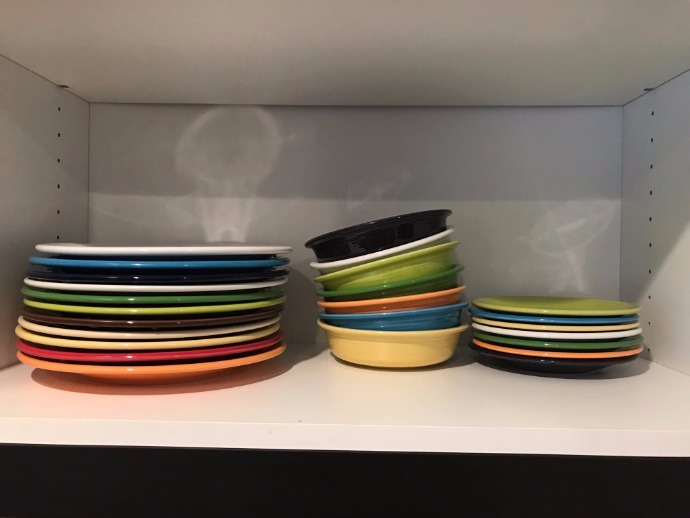Season 2: Episode 6
You are listening to the Shortcut to Slim Podcast. Show details — Hosted by Lindsay S Nixon — Season 2: Episode 6;

Transcript
In this episode we’re learning all about food psychology!
Find out the color of your plate can make you overeat, or eat less, or determine whether a meal will be satisfying or not.
This information is super helpful if you’re trying to eat less without feeling deprived OR if you want to trick your family or yourself into liking healthier fare.
PLUS you’re going learn about a science I’ve wanted to geek out on forever but couldn’t really find the opportunity...
Here’s a hint: it has to do with taste and how dumb your mouth is.
Optical Illusions
I’m obsessed with Brian Wansink and his book, Mindless Eating. This isn’t news.
One of my favorite tips from that book, however, is to use smaller dishes.
I found this exceptionally helpful when I started cutting calories and eating smaller portions.
For me, food filling a small bowl or small plate is MUCH more visually pleasing to look at than a little bit of food on a larger plate.
It just helped to not be reminded I was eating less all the time.
There’s a lot of science around why you should do this too.
The Delboeuf illusion is an optical illusion of relative size perception.
Basically, we misjudge the size of two identical circles when those circles are surrounded by other circles of varying sizes.

From Wikipedia

From Mindess Eating
What this means for us is that larger plates can make a serving of food appear smaller.

This then decreases satiation and satisfaction, leading the diner to feel deprived.
BUT on the positive flipside, smaller plates can lead us to misjudge that very same quantity of food as being significantly LARGER than it really is, helping you to feel satiated and satisfied on less food.

Look how puny OR ABUNDANT a serving can appear purely based on the size of the plate it’s sitting on!!!
Larger plates can also make you serve yourself more food AND make you misjudge how much you’ve eaten.
Take this bowl study for example:
At a health and fitness camp, campers were given large bowl or a smaller one. The campers who took the larger bowl served and ate 16% MORE cereal than those given the smaller bowls.
And get this: even though they were eating MORE cereal, they estimated they ate 7% LESS than the campers with the smaller bowls!
Remember that this was a health and fitness camp.
That means these campers had more experience and awareness with serving sizes than the average person and they still got it wrong.
This shouldn’t be too surprising, though.
You heard me say this over and over in Season 1 that we humans are hideously inaccurate at guessing calories or portion sizes. Even nutrition experts misjudge and underestimate in every study.
If you aren’t losing weight counting calories, I can guarantee part of it is because you eating more than you actually realize.
Alright, so when it comes to bowls and plates, size matters…
but what about the color?
THE COLOR OF PLATES
The color of your plate can nudge you to eat more food or less food.
Specifically, if your food is the same color as your plate, you’ll serve yourself 18% more.
This could be a great strategy in getting picky kids to eat more food:
Use a plate that is the same color as the food being served.
Similarly, if you want to get yourself to eat, say, more salad or kale, serve it on a green plate.
On the other hand, if you want to eat LESS food, do the opposite: Serve it on a plate that isn’t the same color. Contrast is critical.
This next part is super interesting for overeaters: serving food on a red plate tends to reduce the amount diners eat.
Food psychologists speculate this happens because we tend to associate red with danger.
But before you go to Amazon right now and order red plates, consider this:
The color of your plate can also affect TASTE.
I know, this is hard to believe.
How could a plate color possibly affect how food tastes?
But let’s think back to the Jell-O story in episode 2 where the chef put red food dye in lemon Jell-O and all the sailors thought it was cherry...
Or the more recent wine studies where even die-hard wine enthusiasts can be tricked into thinking they’re drinking a Merlot when what they’re actually drinking is white wine colored with red food dye.
If changing the actual color of a food or drink can trick your mind into thinking it’s a different flavor, why wouldn’t the same food TASTE DIFFERENT on different colored plates?
Here’s what experimental psychology researchers have found with plates and taste:
- round, white plates sweet flavors in food
- dark, angular plates bring out more savory flavors
The color of a mug can also alter a drinker's perception of how sweet and aromatic hot cocoa is AND drinks become more “thirst-quenching” when consumed from a blue glass.
My favorite study on this involves brownies.
In that study, 175 people at a cafeteria were given a free brownie and were asked what they thought of it.
Every brownie was the same size and made from the same recipe.
The only difference was how the brownie was presented.
Some folks were handed their brownie on white china.
Others on a paper plate.
Others on a paper napkin.
Those whose brownie came china rated it as excellent.
The paper plate people said it was “good” and the napkin people rated it as “okay but nothing special.”
THIS WAS THE SAME BROWNIE!!
I’m beginning to think this is why my parents like eating at my house so much. My mother is convinced I’m always holding back some secret ingredient because she can’t ever replicate my food exactly at her house.
While it could be as simple as food tasting better when someone else makes it, I think it could also be that I don’t use paper plates.
I need to do more research more on paper plates...
Speaking of my plates:
FIESTAWARE & MY ANECDOTAL EVIDENCE

I own Fiestaware, which means I have a rainbow of different plate color options.
I have two plates I use more than the others: white and navy blue.
I’m pretty territorial with these dishes and it never occurred to me to WHY I favored them, especially when green is my favorite color and we have 2 green plates that I never use.
After learning all this about plate colors I looked back over my instagram photos and realized when the meal is savory, such as at dinner, I use my dark blue plate, or my brown plate if it’s not available.
When the meal is sweet, however, such as pancakes at breakfast, I use the white one or one of the other lighter, brighter colors. Coincidence?!
Here’s a quick summary:
- If you want to eat less, eat on a red plate.
- If you want to eat more eat on a plate that is the same color as your food, meaning if you want to eat more kale, serve it on a green plate.
The power of perception is amazing!!
A quick note about utensils before I move on to the power of presentation.
Utensils can absolutely also change how food tastes too.
For example, in one study, people rated the same yogurt 15% tastier and more expensive when it was sampled on a silver spoon instead of a plastic one.
In another study, people rated cheeses as tasting saltier when eaten off a knife, compared to off a toothpick or fork.
Researchers theorize utensils can create a “mental seasoning”
That because most of us associate silverware with high-quality food and plastic utensils with poor-quality food, food served with fancy cutlery becomes more tasty.
PRESENTATION SENSATIONS
As any instagrammer can attest, how your food is presented matters when it comes to likes.
Restaurant chefs will tell you this too: there is power in plate presentation.
We eat with our eyes so much that that even with super basic dishes, a thoughtful presentation can make the diner rate the simple food as more flavorful.
Simple hacks like cutting meat horizontally, or serving cucumber thinly sliced on top of other salad ingredients have been show to make a meal considerably more appetising AND appear to be more expensive.
In the case of the salad, diners were willing to spend THREE TIMES more for that decorative cucumber!

One extra minute for a thoughtful presentation is all it takes.
Isn’t that minute worth it if it leads to a more enjoyable meal?
This especially applies to children by the way.
Food that is more carefully arranged sets up dinnertime success where food plopped on the plate makes kids suspicious.
Easy tips (with pictures!) how you can plate your food like a pro

A simple garnish can mean the difference between success and failure when feeding picky children or a skeptic partner healthier, plant-centered foods.
Think of it like this:
If you pique expectations that the food will taste great... It will.
To recap:
- Take a second to arrange your food.
- If nothing else, add a garnish.
- Expensive-looking plates and silverware boost perceived quality.
RETRONASAL OLFACTION
Finally, I’ve been wanting to geek out on the nose, specifically retronasal olfaction and how we really taste food since Season 1 (and I’m pretty sure this episode is the best opportunity I’m going to get to get to throw down this bit of science).
What we think of as flavor is actually retronasal olfaction.
Olfaction is the scientific term for smelling through your nose.
For my fellow word and Latin nerds that know retro means “behind” and nasal means “nose” you’ve probably put it together that retronasal olfaction means smelling behind the nose which is a really complicated way of saying mouth smelling.
Now you might be wondering… mouth smelling… what?
I’ll explain.
When you eat, little puffs of air carry the aroma chemicals in the food you’re chewing UP a passage in the back of your mouth to your nose.
This is why when you drink flavored water you don’t really get the taste until you exhale.
This also explains why food tastes off or bland when you’re stuffed up.
Of course, this got me thinking about our other senses.
If our eyeballs and nose can affect what we perceive as taste…
What’s up with the ears?
They’re in this flavor and taste game too.
Researchers have been able to trick chip eaters into thinking stale chips were fresh and fresh chips were stale but putting headphones on them and playing or muffling pre-recording chewing noises.
Turns out our mouth is pretty dumb when it comes to whether or not something tastes good.
In fact, you can only taste sweet, salty, bitter, sour, and umami.
Perceiving anything beyond those five dimensions, such as distinguishing the flavor of an apple from a pear, requires retronasal smell and/or your eyeballs.
This is episode 6 of Season 2.
Download your free 7-day research based meal plan
Leave the science and guesswork to me.
===================================
REFERENCES (SHOW NOTES):
[Title] #link#
Food Psychology: How To Trick Your Palate Into A Tastier Meal http://www.npr.org/sections/thesalt/2014/12/31/370397449/food-psychology-how-to-trick-your-palate-into-a-tastier-meal
The Perfect Meal: The Multisensory Science of Food and Dining,
https://www.popsugar.com/food/Gourmet-Big-Mac-33520475
Sciende Daily: ‘Seeing’ the flavor of foods before tasting them https://www.sciencedaily.com/releases/2013/04/130411194017.htm
http://www.newyorker.com/magazine/2015/11/02/accounting-for-taste
How to plate your food like a pro: Celebrity chefs reveal their secrets http://www.today.com/food/how-plate-your-food-pro-celebrity-chefs-reveal-their-secrets-2D80186757
Gastrophysics: The New Science of Eating - link to Amazon
The Perfect Meal: The Multisensory Science of Food and Dining - link to Amazon
The Color That Makes You Eat Less http://www.womenshealthmag.com/weight-loss/red-plates
The FASEB Journal: The Visual Illusions of Food: Why Plates, Bowls, and Spoons Can Bias Consumption Volume http://www.fasebj.org/cgi/content/meeting_abstract/20/4/A618-c
The Large Plate Mistake http://foodpsychology.cornell.edu/discoveries/large-plate-mistake
JSTOR: Plate Size and Color Suggestibility: The Delboeuf Illusion’s Bias on Serving and Eating Behavior http://www.jstor.org/stable/10.1086/662615
Visual illusions and plate design: The effects of plate rim widths and rim coloring on perceived food portion size https://www.ncbi.nlm.nih.gov/pmc/articles/PMC3947396/
Your Choice In Utensils Can Change How Food Tastes http://www.npr.org/sections/thesalt/2013/06/30/196708393/from-farm-to-fork-to-plate-how-utensils-season-your-meal#
Looks as good as it tastes? Why an attractive plate makes for a tastier dinner https://www.theguardian.com/lifeandstyle/wordofmouth/2015/jul/21/food-presentation-dinner-food-enjoyable
Olfaction: The Nasal Cavity and Smell https://www.boundless.com/psychology/textbooks/boundless-psychology-textbook/sensation-and-perception-5/sensory-processes-38/olfaction-the-nasal-cavity-and-smell-164-12699/
Gastropod: Savor Flavor https://gastropod.com/savor-flavor/
Photo Credits 1 2 3 4
















